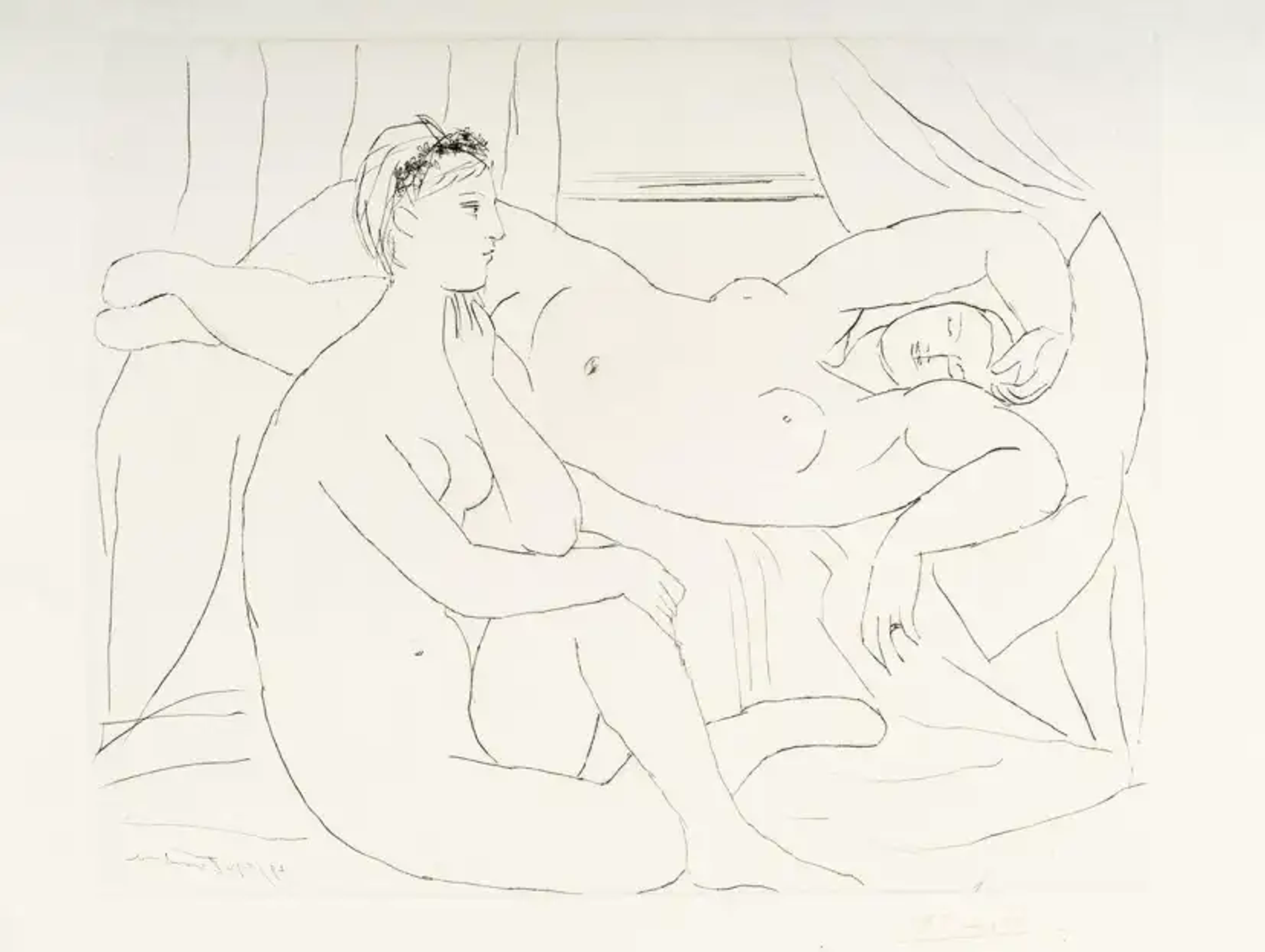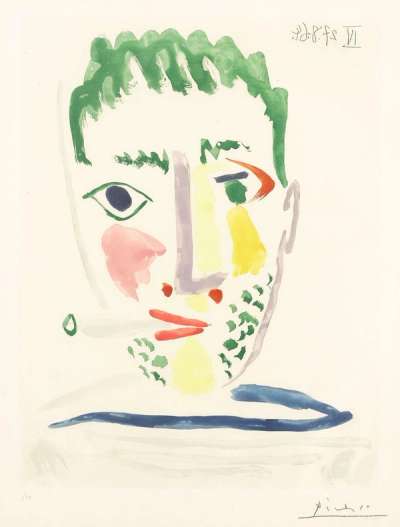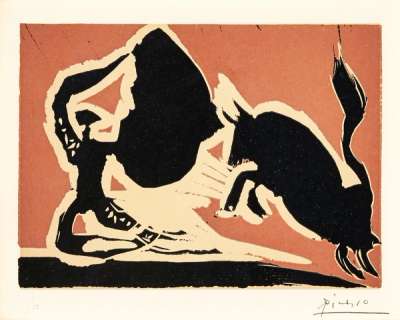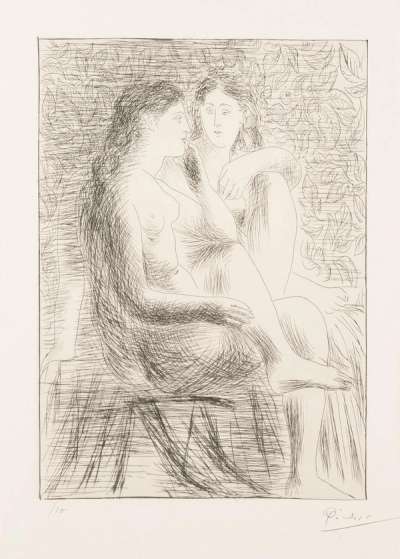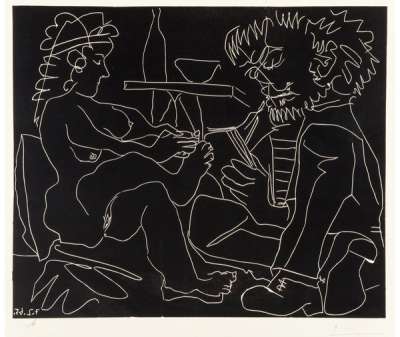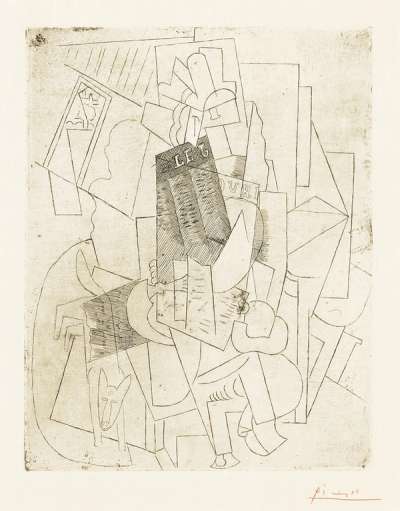 Image © Public Domain / Pablo Picasso in 1908
Image © Public Domain / Pablo Picasso in 1908
Pablo Picasso
155 works
Pablo Picasso, a Spanish painter, sculptor, and co-founder of the Cubist movement, is one of the most influential artists of the 20th century. His innovative approach to form, colour, and perspective revolutionised visual art, making him a pivotal figure in modern art history.
A is for African-Influenced Period
Picasso's work was heavily influenced by Africa between 1907 to 1909, which profoundly impacted the genesis of Cubism. This period was ignited by Picasso's exposure to African art at the Musée d'Ethnographie du Trocadéro in Paris, where he was captivated by the power and expressiveness of African masks and sculptures. Their stark forms and abstracted features inspired him to break away from traditional Western artistic conventions, leading to radical experiments in form, perspective, and representation. Works like Les Demoiselles d'Avignon epitomise this, showcasing a departure towards more simplified, geometric shapes.
B is for Blue Period
Picasso's Blue Period, spanning from 1901 to 1904, marks a profound phase in his artistic journey, characterised by sombre tones and the predominance of blue hues. This period was triggered by the suicide of his friend Carlos Casagemas, leading Picasso to delve into themes of poverty, isolation, and despair. The artworks from this time, such as The Old Guitarist, reflect Picasso's sympathy for the outcasts of society and his own emotional turmoil. The Blue Period is a testament to Picasso's technical prowess and ability to convey deep emotional resonance, offering insight into the human condition. This phase of Picasso's work is a pivotal chapter in his evolution as an artist, highlighting his capacity to translate complex emotions into compelling visual narratives.
C is for Cubism
Cubism, pioneered by Picasso and Georges Braque in the early 20th century, represents a revolutionary break from traditional art forms. This avant-garde movement is characterised by the fragmentation and abstraction of objects into geometric shapes, presenting multiple viewpoints simultaneously to convey a more comprehensive essence of reality. Cubism challenged conventional perspectives on form and space, leading to a fundamental reevaluation of art's role in mirroring life. Cubism's legacy is its profound impact on later modern art movements, establishing a conceptual framework that encouraged further experimentation and abstraction in art.
D is for Drawing
Drawing held a central place in Picasso's artistic practice, serving as the foundational skill from which his revolutionary contributions to modern art sprung. For him, drawing was not just a preliminary step in the creation of his paintings and sculptures but a distinct form of expression that allowed him to explore and refine his ideas with immediacy and precision. His drawings range from simple pencil sketches to intricate ink studies and reveal the artist's extraordinary ability to capture the essence of his subjects with minimal lines. This mastery enabled Picasso to experiment boldly across styles and mediums, facilitating his exploration of form and perspective.
E is for Exile
Picasso's self-imposed exile from Spain was a significant chapter in his life, deeply intertwined with his artistic expression and political convictions. Living in France for the majority of his adult life, Picasso remained profoundly connected to his Spanish roots; his opposition to the Franco regime and the atrocities of the Spanish Civil War fuelled his political activism and artistic direction. This period of exile influenced Picasso's personal identity and solidified his role as a politically engaged artist. Through his exile, Picasso's work became a powerful voice for the suffering and injustices faced by his homeland, marking a pivotal point in his career where art and activism poignantly intersected.
F is Françoise Gilot
A talented artist in her own right, Françoise Gilot is perhaps best known for her romantic relationship with Picasso, with whom she shared a decade-long partnership that profoundly influenced their lives and works. Born in 1921, Gilot met Picasso in 1943, when she was just 21 and he was 61. Despite the vast age difference, their union was a meeting of minds and talent; Gilot was not only Picasso's muse but also a steadfastly independent and creative force. She emerged from Picasso's shadow to establish a significant artistic career characterised by her vibrant colour palette and distinct expressive style. Gilot's memoir, Life with Picasso, offers an insightful glimpse into their tumultuous relationship and her unwavering commitment to her own artistic voice, challenging the traditional muse-artist dynamic and cementing her legacy in the art world.
 Image © Creative Commons via Wikimedia / Picasso's Guernica ready to be installed at the Stedelijk Museum 1953
Image © Creative Commons via Wikimedia / Picasso's Guernica ready to be installed at the Stedelijk Museum 1953G is for Guernica
Guernica, created in 1937, stands as one of the most powerful anti-war paintings in history. Commissioned for the Spanish Pavilion of the Paris World's Fair, the mural-sized canvas was Picasso's response to the bombing of the Basque town of Guernica during the Spanish Civil War by Nazi Germany and Fascist Italy. Through its monumental scale and stark monochromatic palette, Picasso conveys the chaos and agony of war. The painting's fragmented and distorted figures, including a grieving mother, a fallen soldier, and a terrified horse, encapsulate the horror and suffering of civilian casualties. Guernica transcends its historical context, becoming a universal symbol of the tragedies of war and an enduring plea for peace.
H is for Harlequins
Picasso had a fascination with harlequins during his Rose Period (1904-1906), reflecting a deeply personal connection to the circus, performers, and the duality of the human condition. Harlequins, with their colourful diamond-patterned costumes, provided a vibrant subject matter and symbolised the complexity of human social positions. Picasso often portrayed these figures with a sense of melancholy and introspection, embodying the artist's own feelings of isolation despite their seemingly jovial appearance. The harlequin became a proxy for Picasso himself, exploring themes of identity, performance, and the artist's place in society.
I is for Impact
Picasso's impact on his contemporaries was profound and far-reaching, reshaping the landscape of 20th-century art almost from the start. As a pioneering force, he challenged traditional notions of perspective and form, inspiring artists to explore fragmentation and abstraction in their work. Picasso's relentless experimentation across styles and mediums, from surrealism to classical forms, set a precedent for artistic innovation, pushing others to break from convention. His influence extended beyond painting to sculpture, ceramics, and printmaking, encouraging a multidisciplinary approach to art.
J is for Jacqueline Roque
Jacqueline Roque was Picasso's second wife and muse in the later years of his life. They met in 1953 when she was 27 and he was 72, at the Madoura Pottery where she worked. Jacqueline appears in more than 400 of his works, more than any of his other muses. Their marriage lasted from 1963 until Picasso's death in 1973. Jacqueline's presence in Picasso's life marked a period of prolific output and innovation, with her figure dominating his paintings, drawings, and sculptures. She took her own life years after his death, still mourning his loss.
K is for Key Collaborators
Picasso's career was marked by significant collaborations. His partnership with Georges Braque was foundational in the development of Cubism, while his work with the Ballets Russes under Sergei Diaghilev showcased his versatility, contributing striking costume and stage designs that blended visual art with performance. Additionally, his collaboration with the Crommelynck brothers, renowned printers, was pivotal in advancing his graphic work. Their expertise in etching and lithography facilitated Picasso's exploration of printmaking, resulting in some of the most technically sophisticated and artistically compelling prints of the 20th century. Each collaboration allowed Picasso to expand his artistic vocabulary, blending his innovative vision with the unique skills of his collaborators to push the boundaries of what was possible in art.
L is for Legacy
Picasso's death in 1973 only cemented his status as one of the most influential artists of the 20th century. His pioneering work has inspired generations of artists. David Hockney, for instance, has openly acknowledged Picasso's impact on his understanding of space, perspective, and the challenge of representation. Other artists, like Roy Lichtenstein and Jean-Michel Basquiat, have drawn on Picasso's innovative spirit and his bold approach to form and colour. Picasso's ability to constantly reinvent his style and push the boundaries of artistic expression has made him a perennial figure of inspiration.
M is for Minotaur
The Minotaur, a mythological creature with the body of a man and the head of a bull, occupies a central place in Picasso's oeuvre, symbolising the interplay of primal instincts, violence, and passion within the human psyche. This figure became a powerful personal emblem for Picasso, representing his alter ego and appearing recurrently in his works from the 1930s, most notably in the Minotauromachy and the Vollard Suite. The Minotaur's presence in his art reflects his fascination with classical mythology and its capacity to express modern anxieties and contradictions. Through this motif, which appears over 70 times, Picasso explored themes of desire, struggle, and brutality, making the Minotaur a key to understanding his ongoing quest to delve into the darkest aspects of human nature.
N is for Neoclassicism
In the aftermath of World War I, Picasso entered a Neoclassical phase, diverging from the avant-garde to embrace a return to order and traditional forms. This period, spanning the early 1920s, saw him draw inspiration from ancient Greek and Roman art, characterised by harmonious compositions, clear lines, and a serene, monumental quality. Works from this phase exhibit a refined beauty and a focus on the human figure, reflecting a world seeking solace and stability after the chaos of war. Picasso's Neoclassicism highlighted his versatility and deep understanding of classical techniques, further cementing his mastery across diverse artistic styles. This phase contributed to the broader post-war artistic movement that sought to reclaim and reinterpret classical ideals in the modern era.
O is for Originality
Picasso's originality is a cornerstone of his legacy, setting him apart as one of the most innovative artists of the 20th century. His revolutionary approaches to painting, sculpture, printmaking, and ceramics demonstrated a boundless creativity that constantly challenged artistic conventions. Picasso's ability to blend traditional elements with avant-garde techniques reshaped modern art, introducing new perspectives on form, space, and narrative.
P is for Paris
Paris played a pivotal role in Picasso's life and career, serving as the crucible for his artistic evolution. Arriving in 1904, Picasso was immediately immersed in the vibrant avant-garde scene of Montmartre, where he engaged with a network of artists, writers and intellectuals. This dynamic cultural milieu inspired his artistic development, and Paris became an active participant in Picasso's creative process. It offered him the museums, galleries, and bohemian lifestyle that fuelled his work, while the city's artistic freedom and intellectual fervour were instrumental in transforming Picasso into a leading figure of modern art.
Q is for Quantity
Picasso's prolific output, estimated at around 147,800 pieces of art, underscores his unparalleled creativity and tireless work ethic. This staggering number includes paintings, drawings, sculptures, ceramics, prints, and textiles, reflecting a vast exploration of mediums and styles. Picasso's relentless productivity was driven by a constant need to express and innovate, resulting in a diverse body of work that spans over seven decades. Picasso's extensive oeuvre is a testament to his genius, showcasing an insatiable curiosity.
R is for Rose Period
Picasso's Rose Period, spanning from 1904 to 1906, marked a significant shift from the melancholic themes of his Blue Period to a warmer, more optimistic palette. Dominated by shades of pink and orange, this phase reflected Picasso's improved circumstances. The figures in these works, such as Family Of Saltimbanques and Boy With A Pipe, are depicted with a gentle, lyrical quality, embodying a sense of fragile humanity. The Rose Period heralded the beginning of Picasso's continuous evolution as an artist, showcasing his versatility and deepening emotional complexity.
S is for Spain
Spain's profound influence on Picasso is evident throughout his work, shaping his thematic choices, stylistic developments, and artistic identity. Born in Málaga, Spain, Picasso's early exposure to art and culture deeply impacted his aesthetic sensibilities. The intensity and drama of Spanish traditions, folklore, and the stark landscapes are reflected in his use of bold colours, dramatic contrasts, and emotive subjects. Figures like the bull and references to Spanish history and the trauma of the Spanish Civil War, underscore his lifelong connection to Spain's cultural heritage.
T is for The Charnel House
The Charnel House is an unfinished work created by Picasso between 1944 and 1945 as a poignant testament to the horrors of the Nazi regime and the Holocaust, echoing the anti-war sentiment of his earlier masterpiece, Guernica. Rendered in a monochromatic palette, this large canvas depicts a grotesque scene of a slaughtered family in their home. Utilising fragmented forms and a Cubist style, Picasso conveys the chaos and brutality of violence, but left the painting unfinished, in a poignant echo of the never ending horrors of the event.
U is for United Nations
Picasso's political engagement culminated with his work being displayed in the United Nations: a reproduction of Guernica as a tapestry is on show at the UN headquarters in New York. Commissioned by Nelson Rockefeller, its placement at the UN underscores the painting's enduring message against the brutality of war and its relevance to global peacekeeping efforts.
V is for Vauvenargues
Picasso died and is buried at the Château of Vauvenargues, a grand estate located at the foot of Mont Sainte-Victoire in Provence, France, which he purchased in 1958. This picturesque setting served as a tranquil retreat for the artist in his final years. Following his death in 1973, Picasso's final resting place was chosen to be in the château's park, a testament to his deep connection to the landscape.
W is for World Peace Forum, 1949
In 1949, Picasso's involvement with the World Peace Congress led to one of the most enduring symbols of peace. For this, he created the lithograph La Colombe, featuring a white dove against a light background. In the aftermath of World War II, this artwork became more than a representation of peace; it was a call to action, solidifying the dove as an emblem of the peace movement. Picasso's contribution to the World Peace Congress highlighted the artist's ability to communicate universal messages through his art.
Y is for Young Talent
Picasso demonstrated extraordinary artistic talent from a very young age, completing his first painting at the age of nine—a harbinger of the prodigious career that lay ahead. By the age of thirteen, Picasso had not only mastered the classical techniques of drawing and painting but had also begun to surpass the skills of his father, José Ruiz y Blasco, who was himself an accomplished artist and art teacher. This early mastery of art fundamentals set the stage; Picasso's precocious talent and relentless drive to experiment and evolve cemented his status as one of the most influential figures in the history of art, all rooted in a childhood where his extraordinary abilities were already evident.
Z is for Zervos
The art critic Christian Zervos was entrusted by Picasso to compile the catalogue raisonné of his work, a monumental task that Zervos embarked on with dedication. The project began in 1932 with the publication of the first volume, covering works from 1895 to 1906, under Zervos's publishing house, Cahiers d'Art. Despite the project's initial financial challenges, which led Zervos to auction part of his art collection to fend off bankruptcy, the endeavour flourished into a comprehensive 33-volume catalogue raisonné. Documenting Picasso's oeuvre from 1895 to 1972 through nearly 16,000 black and white photographs, this extensive catalogue was compiled in close collaboration with Picasso, who had become a friend of Zervos in 1924. After Zervos's death, Mila Gagarin continued his work, supervising the publication of 11 additional volumes until 1978, fulfilling Picasso's wish for a detailed archive of his artistic legacy.




